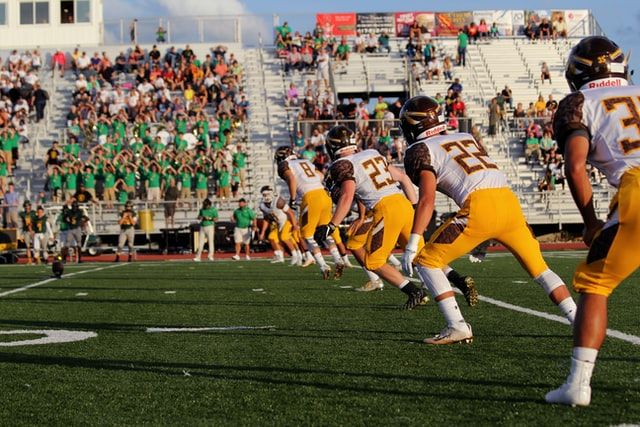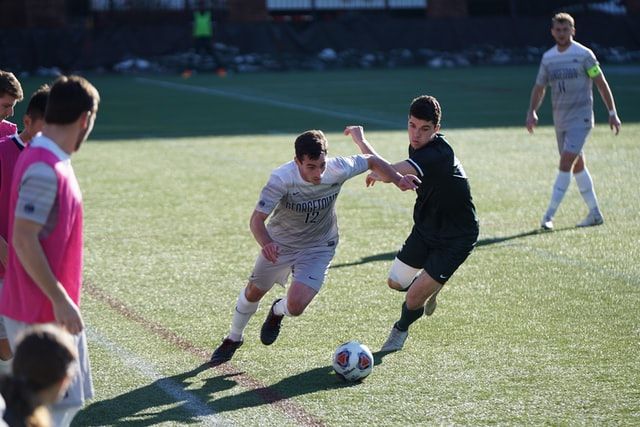Photo by Jeffrey F Lin on Unsplash. Picture shows two young men during a soccer game. Did I retear my ACL graft? During the early recovery phase following an ACL reconstruction, it is unlikely to tear your graft. The chances of retearing your ACL increase significantly when you return to sport following ACL surgery.
After an ACL reconstruction it’s normal to be feeling a bit nervous or scared about using your injured knee. The truth is, for the first few weeks to months after surgery you are unlikely to tear your ACL graft. However, this does not mean it’s impossible, but that it is a rare occurrence early in your recovery.
Before surgeons even stitch up your knee after surgery, they do several vigorous tests to ensure the new ACL is stable.[6] This is important because in the days that follow surgery, you will be expected to put weight through your knee. How much weight you are able to bear during walking, will be up to your surgeon. So you can be confident when you begin your recovery, that the ACL graft is intact, and stable for everyday life.
Sometimes it can be unsettling when you return to walking and you feel yourself step awkwardly, or you find yourself on an uneven surface. However, these little things usually are not enough force to cause your graft to tear.
Am I more likely to tear my ACL again?
The simple answer is yes, if you have torn your ACL once you are at an increased chance of tearing your ACL again. This is true for both knees. Meaning, if you tear your ACL in your right knee, you are more likely to tear either your left or right ACL when compared to someone without any ACL tears. Although this is true, someone who had an ACL tear of their right knee, is more likely to rupture their right ACL than compared to their left ACL . Meaning, whatever side you tore your ACL on is the side more likely to experience another tear.[3] [7]
When am I most at risk to retear my ACL?
As previously mentioned, the minor forces put on your knee in your normal, daily activity is not usually enough force to tear an ACL. Therefore, it makes sense that most grafts will rupture when people are returning to sports, and/or recreational activities. On average, most people return to their pre-injury level of sport around 12 months after their ACL reconstruction[4], though it can be as early as 6 months.[5] Getting back to sports and other high impact activities, such as running, jumping, and pivoting should always be done with the advice of your healthcare team.
Research shows that people were most likely to retear their ACL in the first 24 months after their return to sport, following an ACL reconstruction.[5] [7] Likewise, the chances of retearing your ACL graft increases significantly if you return to sport within 9 months following ACL reconstruction surgery.[2]

Photo by Riley McCullough on Unsplash. Picture shows a young team of football players getting ready to make a play. Did I retear my ACL graft? You are most at risk of tearing your ACL graft when you return to sport following your ACL reconstruction. Returning to sport within 9 months of ACL surgery puts you at a higher chance of tearing your ACL graft. Most people who retear their ACL grafts will have it occur within 24 months of returning to sport after their ACL reconstruction surgery.
What ACL graft is the least likely to have a tear?
Those who received a cadaver allograft, where they take the tissue from a donor, are five times more likely to tear their ACL graft. This was compared to two other types of ACL grafts, the patellar tendon graft, taken from the tissue connecting your thigh muscle to your kneecap, and hamstring tendon autograft, taken from the muscles in the back of your thigh.[3] The hamstring tendon graft was shown to be slightly more at risk of rupturing than the patellar tendon graft, though there was no differences in the quality of the grafts.[3] [8]
How will I know if I retear my ACL?
There are some common signs that you may see if you have torn your ACL[1]:
- Rapid and large amounts of swelling
- A “popping” sound or feeling
- Lots of pain
- Inability to continue playing the sport
Keep in mind that the list is not complete, and having some of these symptoms does not guarantee you have torn your ACL. A diagnosis of an ACL tear can be made by a healthcare provider and or medical imaging.
Conclusion
In the first few months following your ACL reconstruction it’s normal to feel nervous about using your surgical leg. Sometimes all it takes is an awkward step before you begin to worry that you’ve done something horribly wrong. Recovery from ACL surgery is a slow process, and the types of activities you do at the start of your recovery rarely put enough stress on the new graft to cause a tear. This means that it will be very hard to reinjure/rupture your ACL graft right after your surgery. However, once you have torn your ACL once, it is more likely to happen again. The highest chance of another tear happens in the first 24 months after you return to sport, following your ACL reconstruction.
Curovate is an app developed by a physical therapist, designed with the best protocols to guide your ACL rehabilitation. It provides daily exercises, videos, rehab reminders, precautionary notes and so much more! Download Curovate today by clicking the link below, and get started on your rehab journey from the comfort of your home!
If you need further customized assistance during your surgery or injury recovery check out our Virtual Physical Therapy page to book your 1-on-1 video session with a physical therapist.
 |
 |
|---|
Other Blogs Related to ACL Injuries:
- How to prevent ACL injuries
- Why is my knee numb and tingly after ACL surgery?
- Can an ACL injury lead to arthritis in the future?
- Is it normal to still have pain after an ACL reconstruction surgery?
- Should I be experiencing pain when I do my rehabilitation exercises?
- ACL Social Support
- ACL Recovery Timeline
- Why Should I Exercise before My ACL Surgery- the Importance of ACL Prehabilitation







